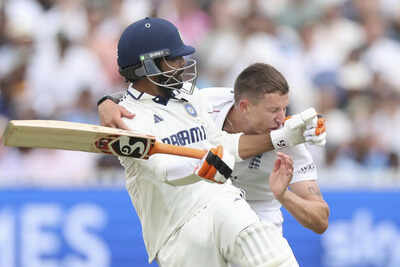Science
Tensions Rise as Jadeja and Carse Clash During Test at Lord’s

The atmosphere at Lord’s Cricket Ground intensified during the fifth day of the third Test match between India and England, highlighted by a heated exchange between India’s Ravindra Jadeja and England’s Brydon Carse. The incident unfolded as Jadeja attempted to run a quick two during the final ball of the 35th over, resulting in a collision that led to verbal exchanges between the players.
Tensions escalated from the start of the day, with England’s Jofra Archer delivering pointed remarks to India’s Rishabh Pant after securing his wicket. Following this, Ben Stokes and Harry Brook added to the verbal exchanges when Nitish Kumar Reddy came to the crease.
Just before the lunch break, Jadeja and Carse collided on the pitch, prompting Carse to make comments directed at the Indian all-rounder. In response, Jadeja clarified that he was merely running between the wickets. The situation intensified when Carse attempted to grab Jadeja, but Stokes intervened to ease the confrontation. Umpires then intervened, speaking with both Stokes and Carse to ensure the match could continue without further incident.
Match Context and Developments
As the day progressed, the stakes were high for both teams. India required 135 runs to secure victory, while England needed to claim six wickets to win the match. England showcased a strong start by quickly dismissing key players, including Rishabh Pant, KL Rahul, and Washington Sundar.
Nitish Kumar Reddy and Ravindra Jadeja sought to steady the innings for India; however, their partnership was disrupted just before lunch when Chris Woakes dismissed Reddy for 13 runs.
The Test had been evenly contested, with both teams scoring 387 runs in their first innings. In the second innings, Washington Sundar made a significant contribution for India by taking four wickets, which helped bowl England out for 192 runs. Despite defending a modest total, England’s bowlers created a competitive atmosphere as the match neared its conclusion.
Real-time updates, scores, and highlights are available through live coverage of the India vs England Test match. The tension on the field reflects the competitive spirit inherent in such high-stakes matches, showcasing the passion of players and fans alike.
-

 World5 months ago
World5 months agoSBI Announces QIP Floor Price at ₹811.05 Per Share
-

 Lifestyle5 months ago
Lifestyle5 months agoCept Unveils ₹3.1 Crore Urban Mobility Plan for Sustainable Growth
-

 Science4 months ago
Science4 months agoNew Blood Group Discovered in South Indian Woman at Rotary Centre
-

 World5 months ago
World5 months agoTorrential Rains Cause Flash Flooding in New York and New Jersey
-

 Top Stories5 months ago
Top Stories5 months agoKonkani Cultural Organisation to Host Pearl Jubilee in Abu Dhabi
-

 Sports4 months ago
Sports4 months agoBroad Advocates for Bowling Change Ahead of Final Test Against India
-

 Science5 months ago
Science5 months agoNothing Headphone 1 Review: A Bold Contender in Audio Design
-

 Top Stories5 months ago
Top Stories5 months agoAir India Crash Investigation Highlights Boeing Fuel Switch Concerns
-

 Business5 months ago
Business5 months agoIndian Stock Market Rebounds: Sensex and Nifty Rise After Four-Day Decline
-

 Sports4 months ago
Sports4 months agoCristian Totti Retires at 19: Pressure of Fame Takes Toll
-

 Politics5 months ago
Politics5 months agoAbandoned Doberman Finds New Home After Journey to Prague
-

 Top Stories5 months ago
Top Stories5 months agoPatna Bank Manager Abhishek Varun Found Dead in Well









